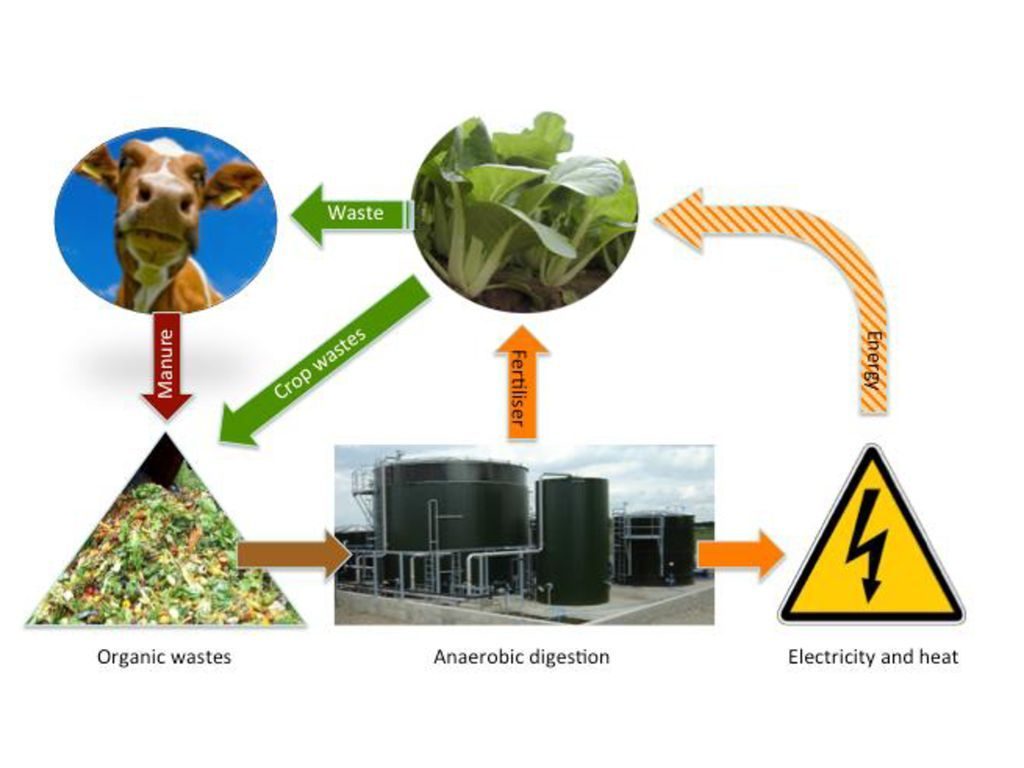Biogas
Biogas is also known as gobar gas. The gases produced by anaerobic decomposition of organic matter such as manure, municipal waste, plant material, agricultural waste, cow dung, sewage, food waste, green waste etc. are called biogas. Thus, biogas is not a one gas but instead it is a mixture of gases.
Carbon dioxide and methane make up the majority of biogas. It is a source of renewable energy. Biogas is created when organic matter decomposes through a process known as anaerobic digestion. In the absence of oxygen, microbes break down the plant or animal waste, releasing gases such as carbon dioxide and methane. Renewable energy sources are gaining popularity around the world. Biogas output is gradually increasing as more people set up biogas plants to generate fuel.
Cow dung is the main source for production of biogas as it contains many bacteria naturally which help in anaerobic decomposition of organic matter. This is the reason biogas is called gobar gas. Cow dung contains methanobacterium which is found in the rumen of the cow's digestive system. Methanobacterium not only produces methane gas but manure as well by decomposition of bio waste.
Composition of Biogas
Composition of biogas may vary according to the substrate used and conditions available for anaerobic decomposition of substrate. It contains methane, carbon dioxide, nitrogen, hydrogen, hydrogen sulfide and oxygen. Typical composition of biogas with percentage of its constituent gases can be written as follows –
Apart from these gases we find water vapor also in biogas. The amount of water vapor depends on temperature, moisture present in the substrate mixture.
Sometimes we get following contaminants also in the mixture of biogases –
Production of Biogas
Biodigestion produces non-polluting gas that actually reduces greenhouse emissions and hence the greenhouse effect. Because there is no combustion involved in the process, there are no greenhouse gas emissions into the environment; hence, using waste gas as a source of energy is an excellent strategy to counteract global warming. Protection of the environment is, unsurprisingly, a major driver for the increased usage of biogas. Biogas facilities help to reduce greenhouse gas emissions by capturing and utilising this dangerous gas as a fuel. Biogas production helps to reduce reliance on fossil fuels like oil and coal.
Production of biogas has been done since ages. It is a very old method of producing fuel and manure using mainly agricultural waste and cow dung. It is done by the reaction of microorganisms such as methanogens (archaeans) and eubacteria. Production of biogas basically is the fermentation of biomass which is done anaerobically in presence of moisture.
It is generally produced at the small scale in rural areas where agriculture is the main profession. An anaerobic digester that treats cow dung and other agricultural waste is called a biogas plant. It is generally made up of brick and cement. Typically, it has following parts –
Mixing tank – It is a medium size tank made up of brick and cement at a height. In this tank cow dung, agricultural waste and other biomass is collected and mixed with water.
Inlet chamber – It is a larger size tank than mixing tank. It is also made up of brick and cement. It connects the mixing tank to the digester.
Digester – It is the largest chamber of biogas plants where the process of anaerobic fermentation takes place. It has a valve on the top from where the produced biogas is released according to the requirement.
Outlet Chamber – It is linked to the digester. It collects slurry and manure after fermentation.
Working of biogas plants – Cow dung, dead plants, agricultural waste, food waste etc. various forms of biomass are mixed with an equal amount of water in the mixing chamber or tank. This mixture is called slurry. Now this slurry is moved into the digester through the inlet chamber. When the digester is almost half filled with slurry, the introduction of slurry is stopped. Digester is closed and oxygen is prevented from entering the digester to let the fermentation process take place actively. pH level in digester should be neutral or seven while temperature should be 30-35℃ for maximum yield. Now the plant is left unused for about 2 months. During these two months anaerobic decomposition of organic matter or fermentation takes place. Eubacteria convert organic material into organic acids, alcohols, acetate, carbon dioxide and hydrogen gas. Archaeans produce methane by using acetate or carbon dioxide and hydrogen gas.
Uses of Biogas
It is commonly used in rural areas as cooking gas.
It can be used for the production of electricity.
It can be used in instruments used for water heating, space (room) heating etc.
It can replace compressed natural gas for use in vehicles.
It can displace carbon dioxide in on-site CHP plants.
It is being used in transport. For example, ‘Amanda Biogas Train’ runs on biogas in Sweden.
Production of biogas produced a very useful dry solid byproduct which is used as manure.
It is used in many states for street lighting purposes.
It can be used in hydrogen fuel cells as well.
Advantages of Biogas
The two biggest advantages are:
Unlike other sources of renewable energy, the process of producing gas is natural and does not require energy. Furthermore, because trees and crops will continue to grow, the raw materials utilised in biogas generation are renewable. Manure, food scraps, and agricultural residue are all readily available raw materials, making it a very sustainable solution.
Overflowing landfills not only disperse bad odours but also allow poisonous liquids to leak into underground water supplies. As a result, another benefit of biogas is that it can help to enhance water quality. Anaerobic digestion also deactivates germs and parasites, making it an efficient way to reduce the spread of waterborne infections. Similarly, in places with biogas facilities, garbage collection and processing improve dramatically. As a result, the environment, cleanliness, and hygiene are all improved.
Some other advantages of biogas are as follows:
Biogas don’t pollute the environment. Thus, it is an eco-friendly fuel. It is a renewable source of energy.It reduces soil, water and air pollution.It produces organic manure as a byproduct. As it is a low-cost method to produce energy, it is economically friendly as well. It encourages a circular economy and is beneficial for all classes.
Biogas don’t pollute the environment. Thus, it is an eco-friendly fuel.
It is a renewable source of energy.
It reduces soil, water and air pollution.
It produces organic manure as a byproduct.
As it is a low-cost method to produce energy, it is economically friendly as well.
It encourages a circular economy and is beneficial for all classes.
It is a healthy cooking alternative specially for developing countries.
The Disadvantage of Biogas
Although advantages are frequently emphasised, there are a few downsides as well. One of the terrible drawbacks of biogas today is that the techniques utilized to produce it are inefficient. There are currently no new technologies that can be used to streamline the process and make it more accessible and affordable. This means that big-scale production to meet the needs of a huge population is still a pipe dream. Despite the fact that today's biogas plants can cover some energy needs, many governments are unwilling to invest in the sector.


